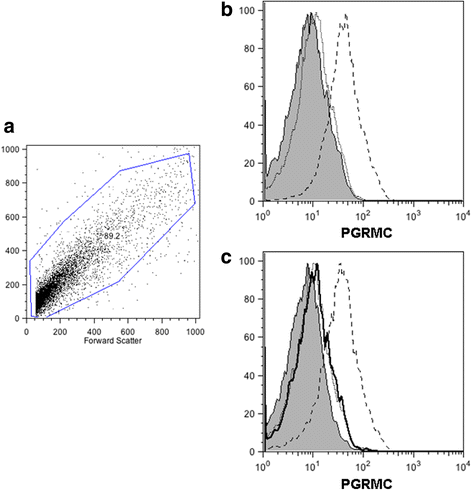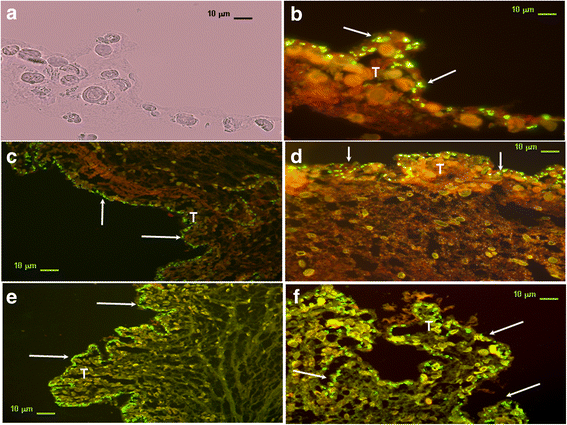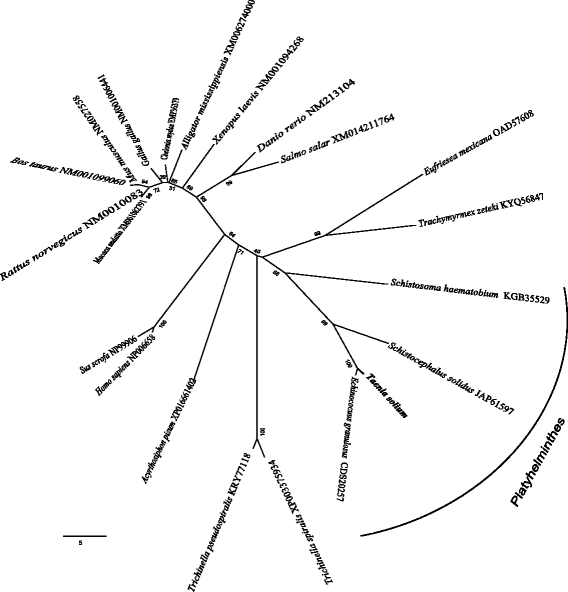A novel progesterone receptor membrane component (PGRMC) in the human and swine parasite Taenia solium: implications to the host-parasite relationship
- PMID: 29523160
- PMCID: PMC5845172
- DOI: 10.1186/s13071-018-2703-1
A novel progesterone receptor membrane component (PGRMC) in the human and swine parasite Taenia solium: implications to the host-parasite relationship
Abstract
Background: We have previously reported that progesterone (P4) has a direct in vitro effect on the scolex evagination and growth of Taenia solium cysticerci. Here, we explored the hypothesis that the P4 direct effect on T. solium might be mediated by a novel steroid-binding parasite protein.
Methods: By way of using immunofluorescent confocal microscopy, flow cytometry analysis, double-dimension electrophoresis analysis, and sequencing the corresponding protein spot, we detected a novel PGRMC in T. solium. Molecular modeling studies accompanied by computer docking using the sequenced protein, together with phylogenetic analysis and sequence alignment clearly demonstrated that T. solium PGRMC is from parasite origin.
Results: Our results show that P4 in vitro increases parasite evagination and scolex size. Using immunofluorescent confocal microscopy, we detected that parasite cells showed expression of a P4-binding like protein exclusively located at the cysticercus subtegumental tissue. Presence of the P4-binding protein in cyst cells was also confirmed by flow cytometry. Double-dimension electrophoresis analysis, followed by sequencing the corresponding protein spot, revealed a protein that was previously reported in the T. solium genome belonging to a membrane-associated progesterone receptor component (PGRMC). Molecular modeling studies accompanied by computer docking using the sequenced protein showed that PGRMC is potentially able to bind steroid hormones such as progesterone, estradiol, testosterone and dihydrodrotestosterone with different affinities. Phylogenetic analysis and sequence alignment clearly demonstrated that T. solium PGRMC is related to a steroid-binding protein of Echinoccocus granulosus, both of them being nested within a cluster including similar proteins present in platyhelminths such as Schistocephalus solidus and Schistosoma haematobium.
Conclusion: Progesterone may directly act upon T. solium cysticerci probably by binding to PGRMC. This research has implications in the field of host-parasite co-evolution as well as the sex-associated susceptibility to this infection. In a more practical matter, present results may contribute to the molecular design of new drugs with anti-parasite actions.
Keywords: Cysticerci; Helminth; Hormone receptors; PGRMC; Parasite; Progesterone; Taenia solium.
Conflict of interest statement
Ethics approval
Animal care and experimentation practices at the School of Veterinary, UNAM, Cuautitlán, were evaluated and approved by the Institute’s Animal Care and Use Committee, and by governmental agencies, in strict accordance with the recommendations set forth in the Guide for the Care and Use of Laboratory Animals of the National Institutes of Health of the USA, to ensure compliance with established international regulations and guidelines. Pigs were euthanized to obtain parasites by expert veterinary surgeons that used sodium pentobarbital anesthesia according to previously approved protocols in an effort to reduce animal suffering.
Consent for publication
Not applicable
Competing interests
The authors declare that they have no competing interests.
Publisher’s Note
Springer Nature remains neutral with regard to jurisdictional claims in published maps and institutional affiliations.
Figures






Similar articles
-
Progesterone induces scolex evagination of the human parasite Taenia solium: evolutionary implications to the host-parasite relationship.J Biomed Biotechnol. 2010;2010:591079. doi: 10.1155/2010/591079. Epub 2009 Dec 13. J Biomed Biotechnol. 2010. PMID: 20037735 Free PMC article.
-
Molecular identification of a PGRMC-2 receptor in maturing oocytes of the zoonotic nematode parasite Trichinella spiralis.Vet Parasitol. 2022 Feb;302:109662. doi: 10.1016/j.vetpar.2022.109662. Epub 2022 Jan 22. Vet Parasitol. 2022. PMID: 35121267
-
Steroid hormone production by parasites: the case of Taenia crassiceps and Taenia solium cysticerci.J Steroid Biochem Mol Biol. 2003 Jun;85(2-5):221-5. doi: 10.1016/s0960-0760(03)00233-4. J Steroid Biochem Mol Biol. 2003. PMID: 12943707 Review.
-
Different effects of chorionic gonadotropin on Taenia crassiceps and Taenia solium cysticerci cultured in vitro.J Parasitol. 2007 Dec;93(6):1518-20. doi: 10.1645/GE-1196.1. J Parasitol. 2007. PMID: 18314702
-
The genome project of Taenia solium.Parasitol Int. 2006;55 Suppl:S127-30. doi: 10.1016/j.parint.2005.11.020. Epub 2005 Dec 6. Parasitol Int. 2006. PMID: 16337432 Review.
Cited by
-
Sex Difference in Amebiasis.Curr Top Microbiol Immunol. 2023;441:209-224. doi: 10.1007/978-3-031-35139-6_8. Curr Top Microbiol Immunol. 2023. PMID: 37695430
-
Characterization of Membrane-Associated Progesterone Receptor Component-2 (MAPRC2) from Trichinella spiralis and Its Interaction with Progesterone and Mifepristone.Vaccines (Basel). 2021 Aug 23;9(8):934. doi: 10.3390/vaccines9080934. Vaccines (Basel). 2021. PMID: 34452060 Free PMC article.
-
Taenia solium Cysticercosis and Its Impact in Neurological Disease.Clin Microbiol Rev. 2020 May 27;33(3):e00085-19. doi: 10.1128/CMR.00085-19. Print 2020 Jun 17. Clin Microbiol Rev. 2020. PMID: 32461308 Free PMC article. Review.
-
Sex-the most underappreciated variable in research: insights from helminth-infected hosts.Vet Res. 2022 Nov 17;53(1):94. doi: 10.1186/s13567-022-01103-3. Vet Res. 2022. PMID: 36397174 Free PMC article. Review.
-
Steroid hormone binding and modulation of Trichinella spiralis progesterone receptor: A computational approach.Biochem Biophys Rep. 2025 May 5;42:102031. doi: 10.1016/j.bbrep.2025.102031. eCollection 2025 Jun. Biochem Biophys Rep. 2025. PMID: 40458199 Free PMC article.
References
-
- Fan PC, Chung WC. Sociocultural factors and local customs related to taeniasis in east Asia. Kaohsiung J Med Sci. 1997;165:647–652. - PubMed
Publication types
MeSH terms
Substances
Grants and funding
LinkOut - more resources
Full Text Sources
Other Literature Sources
Research Materials

